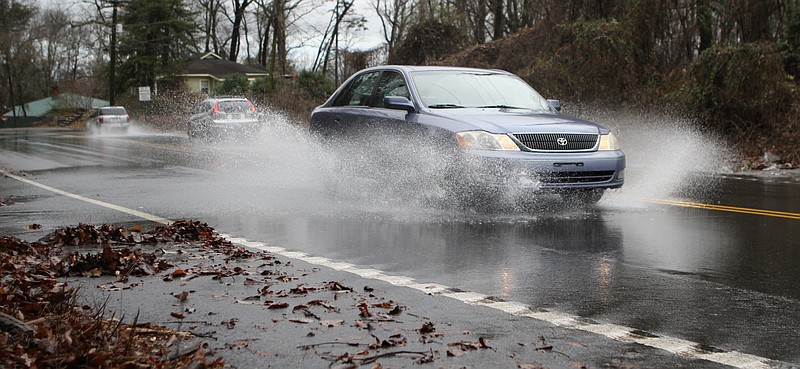The Tennessee Department of Transportation is finally getting ready to pursue one of its three proposed projects for the main road leading up Signal Mountain.
The green light comes thanks to Gov. Bill Haslam's IMPROVE Act, which was signed into law this April and went into effect in July. The bill will incrementally raise gas and diesel taxes by 6 cents and 10 cents, respectively, over the next three years to provide funding for 962 shelved transportation projects across the state.
The chosen option will carry out a series of spot improvements along Signal Mountain Boulevard, costing a total of $10.2 million, according to estimates made when the plan was last presented in 2012.
The work will include upgrading drainage ditches, rebuilding sections of the road where stability is of concern and mitigating the chance of rock falls in problem areas.
Local IMPROVE Act projects
› Widening of Interstate 24 beginning at I-59 on the Georgia line and continuing 10.3 miles to U.S. 27 in downtown Chattanooga. Estimated cost: $171.5 million.› Upgrade interchanges on I-24 at Broad and Market streets to rework ramps and improve access from I-24 to the Southside. Estimated cost: $37 million.› Work on six I-24 bridges, including over Rossville Boulevard ($6.2 million), eastbound lanes over Broad Street ($4.2 million), over old Southern Railway lines ($2.9 million), over Germantown Road ($3.2 million), over Central Avenue ($4.6 million) and Williams Street ($3 million)
The improvements will take place along the 3-mile stretch of Signal Mountain Boulevard that runs from Suck Creek Road at the bottom of the mountain to Palisades Drive at the top. Signal residents have long expressed concerns about the road, which has experienced rock slides, structural failures and traffic delays due to "significant degradation" dating as far back as 1975, TDOT reported in a 2011 study.
One particular area of concern has been a section of the road near Palisades Drive that collapsed due to heavy rain in 2009.
"That has been one of the overlying, major issues in our community that gets discussed," town of Signal Mountain Mayor Chris Howley told TDOT representatives during a recent meeting to discuss the road.
TDOT's three proposals to remedy the ongoing problems are not new.
One option, initially proposed years before the 2009 incident, was to reconstruct the road - which currently transitions from three to two lanes - adding more lanes and 8-foot shoulders for an estimated $75 million.
While the widening would have increased the road's reliability and decreased travel times for the more than 15,000 motorists who use it daily, the project was initially shelved due to residents' worry that it would detract from the area's small-town feel and scenic beauty.
"The construction techniques that you described as wonderful to an engineer would probably not be well received [by Signal residents]," Vice Mayor Dick Gee told TDOT representatives at the meeting.
The plan met further opposition when presented in 2012 because of its obstructive construction process, which would have completely closed the road for two years, routing most traffic to the W Road, and would have caused partial closures for another six months.
"My observation here is that sometimes the cure is worse than the ailment," said TDOT Chief Engineer Paul Degges.
The other proposed option was to add lanes at the top and bottom of the W Road to relieve some of the burden felt on Signal Mountain Boulevard.
The approximately $114 million project wouldn't have required the closing of Signal Mountain Boulevard, but it would have increased the W Road's total length to 6.2 miles, meaning a longer travel time for drivers - and a very high price tag - said Steve Allen, director of TDOT's strategic transportation investments division.
"And nobody really liked that idea," he admitted, adding that the option would have also forgone any improvements to the main route up the front of the mountain.
Transportation officials said they felt the spot improvement plan for Signal Mountain Boulevard may be the plan best suited for Signal Mountain, as it is the least obtrusive from a visual and traffic standpoint while preparing the road to handle the 18,000 cars expected to commute on the route by 2040. The spot improvements, however, will require a greater amount of continued maintenance along the road than the other two proposed scenarios.
"We feel that this would address the majority of the issues," Allen said, adding, "But that doesn't mean that 10, 15 years from now we wouldn't have an unexpected location that we would end up having to fix with maintenance."
TDOT representatives said they are still in the planning stages, and will seek public input before starting their design work. TDOT will also need to complete an environmental impact survey, which officials said could take 12-18 months.
While the IMPROVE Act is expected to bring in an estimated $10.5 billion for the department's 962 backlogged road projects, TDOT will only get about $2 billion per year, Degges said, meaning that not every project will immediately see funding when those dollars are allocated for fiscal year 2018-2019 this July. The goal, he said, is to get the construction phase for every project funded over the next 12-14 years.
"That doesn't mean you're last, but that doesn't mean you're first, either," Degges said. "But certainly you have support from the General Assembly for your project."
